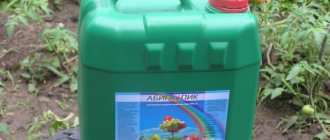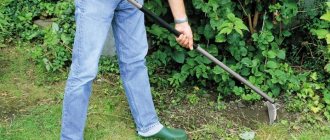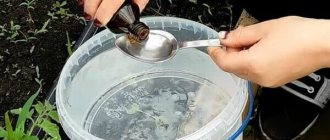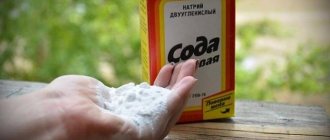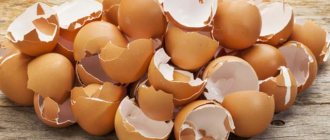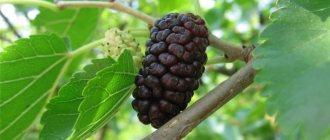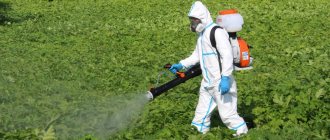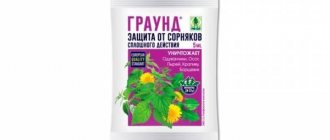Mechanism of action of Roundup
One of the most significant advantages is the unique formula of the continuous action herbicide Roundup, due to which it does not accumulate in the soil. After treatment, the herbicide quickly disintegrates into natural substances, which in turn allows the soil to be used for planting any cultivated plants after several weeks.
The main property of Roundup is its special mechanism of action, which allows it to destroy weeds. It can be described as follows: after this drug gets on the leaves and stems, the chemicals contained in its composition penetrate inside and begin a destructive effect at the molecular level, gradually reaching the roots.
5-6 days after treating the area, the first signs of weed wilting appear. After 2-3 weeks, the weeds die completely.
Important! Spraying the area with this drug should be carried out only in dry and sunny weather to increase the effectiveness of its effect.
The drug will not bring the desired result if it starts to rain immediately after the procedure.
In Russia you can find it on sale in several dosage options:
- Roundup contains 360 g/l of active ingredient.
- Roundup Max - 450 g/l.
- Roundup Extra - 540 g/l.
For ease of use, the product is packaged in different quantities:
- Roundup ampoules ampoules 50 ml per 100 ml, suitable for treating small areas.
- A 1 liter bottle will be enough to carry out the procedure on the territory of an entire subsidiary farm.
- Roundup in 20 liter canisters is used to clear large areas and agricultural lands of weeds.
Watch the video! Roundup - how to fight weeds on the site and in the garden
Characteristics and properties of the product
To save effort and energy, farmers purchase various means and tools to combat weeds. Such means of control include:
- shovels of different shapes and types;
- chemicals;
- flat cutters.
But Roundup for weeds is difficult to compare with them. Under standard conditions for growing vegetable crops, the owner of the dacha spends from morning to evening on the land plot to treat pests and remove weeds.
At the same time, plants of this type have a much longer root system, which complicates the harvesting process. A miracle shovel cannot completely remove the root in 90% of cases. The use of Roundup provides:
- ease of use;
- processing large areas;
- no need to use force;
- saving time and effort;
- complete elimination of weeds on the ground.
The main advantage of Roundup is the absence of harm to humans and animals. Plus, it does not harm plants. At the same time, during processing it is important to observe all precautions: the presence of protective clothing, a clear dosage.
Need to know! With Roundup there is a real opportunity to eliminate dandelions that appear in mid-spring and haunt the garden throughout the entire summer season. It will also remove thistle. The plant is difficult to eliminate due to the special structure of the root.
Composition and active substance
- Glyphosate is the active ingredient.
- Surfactant – increases the stickiness of the product to the surface of plant leaves.
Glyphosate or isopropylamine salt belongs to a group of non-selective systemic herbicides. This substance destroys any plants without selectivity. The only exceptions are genetically modified species.
Interesting! In terms of volumes of use and production, Roundup ranks first among herbicides in all countries.
Application area
Roundup Max herbicide can be used throughout the season. The first procedure is supposed to be in early spring, as soon as the snow melts and the first grass appears on the soil. But Roundup should be bred following the necessary rules. They are written on the packaging by the manufacturer.
If the garden is very densely planted with shrubs and fruit plants, it will take several years in a row to cultivate the soil. First year: perennial plants that must be completely eliminated.
Second year: complete cultivation of the site and planting of vegetables, flowers, fruits in the ground. Concerned about the re-emergence of weeds - transformation into humus.
To plant lawn grass, it is initially treated with Roundup. After 2-3 weeks, plant the lawn in the ground. The weather during the event should be warm, calm, and without high humidity.
Cover shrubs and trees with roofing felt (other dense material) before pollination. Apply the herbicide carefully. Planting new plants is not recommended. The most useful and effective procedure will be in the spring. The result lasts throughout the season.
When to use
You can treat a plot with Roundup throughout the entire growing season: autumn, spring or summer.
How to dilute the working solution: dosage and consumption rate
Preparation of a working herbicide solution is quite simple:
- You need to take 100 g of highly concentrated product.
- Dissolve in 10 liters of water.
- This amount is enough to treat an area of up to 200 sq. m.
- The prepared solution can be stored for up to 7 days in a closed container.
Consumption rates and dosage
For areas where spring-sown crops are grown, which include: grains, melons, vegetables and flowers, the application rate is per 200 sq. m is:
- 10 liters of water;
- 120 ml of the drug.
Treatment should be carried out in the fall, immediately after harvesting.
Areas for perennial grasses should be cultivated in autumn or spring, 2 weeks before sowing:
- a solution prepared in a proportion of 120 ml per 10 liters of water;
- The product consumption will be 10 liters per 200 sq. m.
The consumption of the solution for treating areas of fruit plants is 5 liters per 100 sq. m. To prepare it you should take:
- 80 ml of product;
- 10 liters of water.
It is recommended to carry out the procedure in spring or summer, at least 2 weeks before harvest.
For spraying grapes, a solution prepared in the following proportions is suitable:
- 80 ml of active ingredient;
- for 10 liters of water;
- The consumption of the product will be 10 liters per 200 sq. m.
In the summer, at least 2 weeks before harvesting a mature crop.
Treatment of areas with grains is carried out no later than 2 weeks before harvesting, with a solution in the following proportions:
- 3 l of the drug;
- for 500 liters of water;
- taken per 1 hectare of crops.
- the product consumption will be 10 liters per 200 sq.m.
Areas sown with corn should be sprayed with the solution 2-3 weeks before sowing,
The solution should be prepared in the following proportions:
- 120 ml of product;
- for 10 liters of water.
Areas for potatoes and beets are cultivated 2 weeks before sowing:
- the product should be taken in a proportion of 40-60 ml per 10 liters of water;
- consumption will be 10 liters per 200 sq.m.
Soil intended for growing sunflower and soybeans should be processed 3-5 days before sowing the seeds.
- The solution consumption will be 10 liters per 200 sq.m;
- For 10 liters of water, add 80 ml of product.
Areas that will not be used for planting any crops can be treated at any time:
- the consumption of the product will be 10 liters per 200 sq.m;
- To prepare it, you should take 80-120 ml of the drug per 10 liters of water.
Instructions for use of Roundup
For temperate climates, the manufacturer recommends certain procedures for using the drug:
- in climates with long winters, it is advisable to use the herbicide after the appearance of green weeds on the site, but before planting cultivated plants. It is optimal to treat weeds whose growth has reached a height of 5...12 cm;
- in conditions with short winters (there is no stable snow cover), it is recommended to carry out treatment as plants appear on paths, in vegetable gardens and orchards before cultivated trees, shrubs and planted seedlings bloom;
- limited use of the drug in the summer. If processing is necessary, you need to use shields that block access to vegetable and garden crops;
- In the fall, you can use Roundup on perennial weeds, treating paths and beds in the garden after harvesting. In gardens, spray the herbicide without lifting the sprayer from the ground (drops that fall on green branches and leaves can destroy cultivated plantings).
Pros and cons of herbicide
Using a chemical herbicide to treat a site has many advantages over manual methods of cultivating the land.
The main advantages of the product include:
- ease of use and reduced labor costs;
- efficiency and fast validity, with a single treatment;
- complete destruction of weeds;
- reducing the number of procedures that involve loosening and maintaining soil moisture;
- complete disintegration of the substance when it enters the soil without negative effects on the seeds.
The product has the following disadvantages:
- low toxicity, the product has hazard class 3;
- the drug is incompatible with other chemicals;
- negative impact on the soil microbiome;
- in case of accidental contact with cultivated plants, it destroys them.
Advantages and disadvantages of Roundup
For humans, roundup does not cause harm. Despite the fact that agricultural stores offer a large selection of drugs, this substance is undoubtedly an advantage due to its abilities:
- Safe. Effective herbicide. Using it in the garden in compliance with all the rules and regulations described in the instructions, weeds will not bother you.
- After treatment with Roundup, gardeners ensure not only clean soil, but also excellent seed survival and increased yield.
- Saves time, effort and energy of a person. However, it is only harmful to weeds. Cultivated plants are not damaged and develop faster. The effect continues into the next season.
- There is no need to wait for time to plant seeds and seedlings.
- It is used not only to kill grass, but also to protect trees from erosion.
Roundup analogs
Glyphosate is a substance that is an active base in several brands of products.
The following drugs can be found on sale:
- "Tornado";
- "Hurricane";
- "Zeus";
- "Napalm";
- "Liquidator" and others.
The action of all these drugs has a similar mechanism; they are distinguished from each other only by the concentration and dosage of the active substance. When preparing a solution for spraying, you should strictly follow the points specified in the instructions.
If it's scary, but really necessary
Since Roundup really quickly and reliably copes with unwanted vegetation on the site, its use is justified in the following cases:
- Clearing heavily overgrown areas or virgin lands from weeds, trees, and bushes. Having carried out the treatment in the fall, in the spring the gardener will clear the area of plant residues and begin to develop the land for planting garden crops.
- Destruction of weeds that cannot be eradicated by hand weeding on land intended for ornamental plants. Work begins at the beginning of the season or in the fall.
- Planned sowing a year after treatment, while the land, freed from thickets, rests fallow. Option for planting grain and vegetable crops. Over the course of a year, the poisons will partially decompose and in the half-life stage will not be so dangerous.
- Cleaning areas along the fence or behind it, along the perimeter of the site.
- Treating areas for sowing lawns where fruits and vegetables will definitely not grow.
Experts recommend using not the basic Roundup, but its equivalent, Max, which is valid in the Russian Federation until March 2024.
A product with the same degree of danger and effectiveness. But Roundup Max has a number of advantages, the main one being speed. Comparative characteristics are given in the table:
| Parameter | "Roundup" | "Roundup Max" |
| Duration of complete absorption (in the absence of precipitation) | From 6 hours | 1 hour |
| Time required for first manual harvesting | 7 days | 1 day |
| Temperature range for processing | From +15 °C to + 25 °C | From +2 °C to +30 °C |
| Optimal air humidity (required minimum) | 70% | 50% |
| Composting or plowing tops of dead weeds | No, only burning | Yes, in a week |
In addition to the listed criteria, Roundup Max’s ability to destroy rhizomatous and herbaceous perennials the first time reaches 100%, while the opponent’s ability does not exceed 70%.
Both drugs show maximum effectiveness on young plants that are not yet ready to flower:
- weeds - no later than the 4th leaf;
- burdock, thistle, thistle - until the flower arrow comes out.
Regrowth is the result of newly sprouted weed seeds.
Safety precautions and storage of the drug
Products based on glyphosate are low toxic to humans, animals and insects. Preparations containing this substance have a hazard class of 3. But it should be remembered that direct contact may cause an allergic reaction.
In order to minimize the negative impact of the product, you should adhere to the following rules for working with it:
- When preparing the solution, you should use personal protective equipment: wear the most closed clothing, hat, respirator or mask. Work should be carried out with gloves and closed shoes.
- The solution should be prepared in a container not intended for food consumption.
- Do not come into contact with food, eat or smoke while working with the drug.
- If the product gets on your hair, skin or mucous membranes, rinse the affected area with plenty of running water.
- After treatment, remove protective clothing, take a shower and wash your hair thoroughly.
- In case of accidental ingestion, you should drink as much water as possible, then try to induce vomiting and take several tablets of activated charcoal.
- The product must be stored in a dry place, away from food and medicine, away from children and animals.
The shelf life of the drug is 5 years. After use, the empty container should be disposed of. Storage conditions for the drug include a temperature range of -15 to +30 degrees.
Advantages of the drug
If we compare Roundup with other herbicides, we can note some advantages:
- It effectively removes all weeds from the site, but does not change the structure of the soil; it remains fertile and moist.
- Using Roundup reduces the likelihood of soil erosion.
- Crops can be planted in the soil almost immediately after treatment.
- The use of the drug allows you to significantly save your energy and time, which is spent on many hours of exhausting weeding.
- It is enough to treat the area once every 2-3 months to guarantee reliable protection against weeds.
- Summer residents have noticed that treating the soil with Roundup increases seed germination.
If you use the product exactly according to the instructions, you can guarantee its safety and maximum effectiveness not only for humans, but also for beneficial insects.
Lifehack for security
Experts recommend that private owners use a special roundup breeding scheme. This is not about human safety (observance of the described precautions is not canceled), but about reducing the risk to the soil. The method will require efficiency. The solution will lose its effectiveness within an hour after preparation, but the decomposition of glyphosate will not have such a detrimental effect on the health of fertile soil, and the result of the treatment will even exceed expectations.
The essence of the method is that the drug must not be diluted in ordinary water. The toxic liquid is added to a 5% urea solution. At the same time, to spray one hundred square meters of land, the same 5 liters will be required as in conventional schemes (see below), and the dosage of the drug is significantly reduced. Instead of the recommended 40 to 120 ml for clean water (for various weeds), only 18 ml is required. If powder is used, then the proportion is 0.5 kg per bucket. That is, in terms of consumption, this option for killing weeds is even more profitable.
The frequency of such processing is no more than 1 time per year.
